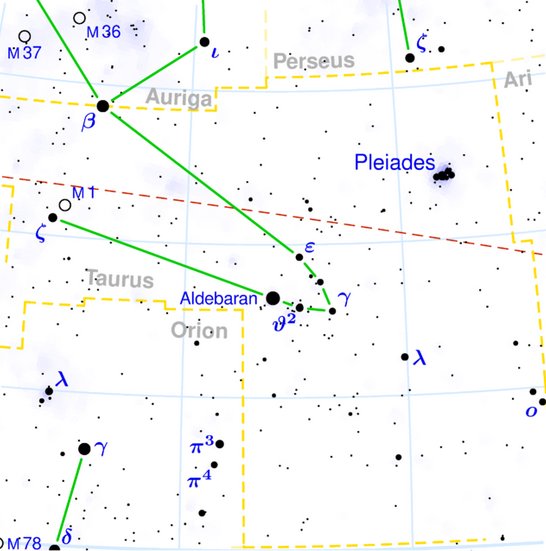Once again. Initially I intended only to upgrade my G text presentations with more heliacal stars and with dates also for the time of Al Sharatain. However, the encountered discoveries made me gradually extend the scope, resulting in presentations also of the dates at the time of Bharani and at the time of Gregory XIII. Furthermore, my presentations of the C text included nakshatra dates and such information had proved valuable so I adopted this method also for the G text. Later I came to realize the text needed to 'come alive'. Pictures would convey (if chosen with care) the background necessary for a better understanding of the glyph sequences. Therefore I decided to begin with this magnificent beast in order to complement the rest of the information:  Its blue head with golden horns probably means this bull represented the Heavenly Bull, i.e. the Taurus constellation.
But obviously I also had to use star charts:
The format of the star chart above allowed me to add a few number manipulations in order to focus attention on how the text perhaps was not alphabetical at all but calendarical.
I used 4 * 2 = 8 sequences of dates relating to the heliacal stars in rongorongo times. First I highlighted the corresponding dates in rongorongo times and then I also highlighted the corresponding nakshatra dates in the time of Al Sharatain: The distance from the dates of my assumed heliacal calendar in rongorongo times to the dates in my from the C text perceived Al Sharatain lunar (nakshatra) calendar are 300 - 144 = 156 days (not 366 / 2 = 183 days), because precession had moved the Sun 27 (= 183 - 156) days earlier in the year (since the time around 71 * 27 = 1900 years previously when the heliacal and lunar calendars could have been made to 'walk hand in hand'). According to the heliacal calendar the stars had moved 27 days in the opposite direction (i.e. ahead), and therefore 300 + 27 - 144 = 183 (= 366 / 2). It was unavoidable to present the differences between these 8 date sequences in detail in order to make some sense of them and also to illuminate some of the possible number plays: However, the text could also allude to the time when 0h was at the star Bharani (41 Arietis), with Ga1-1 at "April 14 (which can be written 4-14 and counted as 414 = 9 * 46) - to be compared with 427 (4-27) = 4 * 61 and 413 (4-13) = 4 * 59. According to my reconstructions: in rongorongo times Bharani rose with the Sun 41.4 (cfr 414) days after 0h. Aldebaran came 27 days later, 41 + 27 = 68 days after March 21 (80), i.e. Aldebaran rose with the Sun in May 28 (148). Moreover, from the first year of the Gregorian calendar (1582 A.D.) to 1842 A.D. (which I have used as a possible 'zero'-year for the rongorongo calendar texts) there are 260 years, and 260 / 71 = ca 3.66 days. Therefore, due to the precession, the stars in 1842 A.D. must have risen around 4 days later than in the time of Gregorius XIII. This could explain why the glyph for heliacal Aldebaran (Ana-muri) was placed not at the beginning of side a but 4 days later:
I decided to highlight the dates for the time of Gregorius XIII because the creator of the G text seems to have intended to show the differences between the dates according to the Gregorian calendar and the dates where the heliacal stars were around 260 years later, viz. 4 days later. 4 * 71 = 284 is remarkably close to the distance from March 21 to the end of the year. 80 + 284 = 364 = 14 * 26. 1582 A.D. + 284 = 1866 A.D. ... The officers of the Chilean corvette O'Higgins received this tablet and the Large Santiago Tablet from Father Roussel on Rapa Nui in 1870. |



